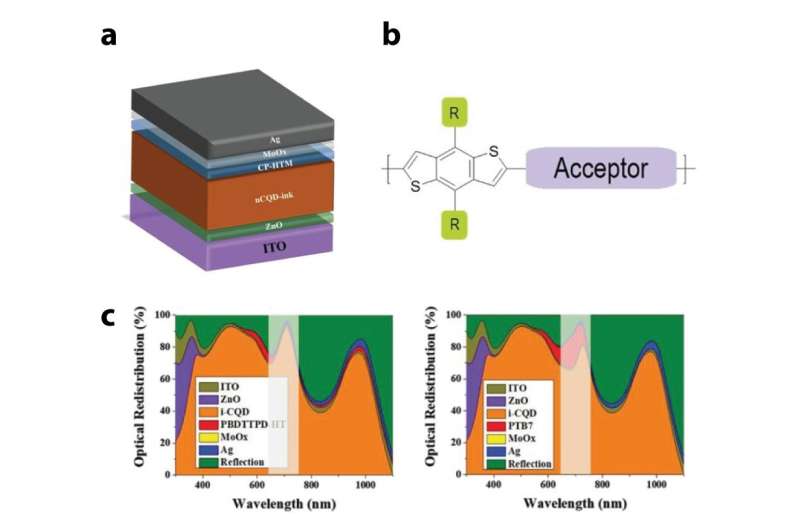Enhancing quantum dot solar cell efficiency to 11.53%

A novel technology that can improve the efficiency of quantum dot solar cells to 11.53% has been unveiled. Published in the February 2020 issue of Advanced Energy Materials, it has been evaluated as a study that solved the challenges posed by the generation of electric currents from sunlight by solar cells by enhancing the hole extraction.
A research team, led by Professor Sung-Yeon Jang in the School of Energy and Chemical Engineering at UNIST has developed a photovoltaic device that maximizes the performance of quantum dot solar cells by using organic polymers.
Solar cells use a characteristic of which electrons and holes are generated in the absorber layer. The free free electrons and hole then move through the cell, creating and filling in holes. It is this movement of electrons and holes that generate electricity. Therefore, creating multiple electron-hole pairs and transporting them are an important consideration in the design of efficient solar cells.
The research team switched one side of the quantum dot solar cells to organic hole transport materials (HTMs) to better extract and transport holes. This is because the newly-developed organic polymer not only possesses superior hole extracting ability, but also prevents electrons and holes from recombining, which allow efficient transport of holes to the anode.
Generally, quantum dot solar cells combine electron-rich quantum dots (n-type CQDs) and hole-rich quantum dots (p-type QDs). In this work, the research team developed organic π‐conjugated polymer (π‐CP) based HTMs, which can achieve performance superior to that of state‐of‐the‐art HTM, p‐type CQDs. The molecular engineering of the π‐CPs alters their optoelectronic properties, and the charge generation and collection in colloidal quantum dot solar cells (CQDSCs), using them are substantially improved.
As a result, the research team succeeded in achieving power conversion efficiency (PCE) of 11.53% with decent air‐storage stability. This is the highest reported PCE among CQDSCs using organic HTMs, and even higher than the reported best solid‐state ligand exchange‐free CQDSC using pCQD‐HTM. "From the viewpoint of device processing, device fabrication does not require any solid‐state ligand exchange step or layer‐by‐layer deposition process, which is favorable for exploiting commercial processing techniques," noted the research team.
"This study solves the problem of hole transport, which has been the major obstacle for the genration of electric currents in quantum dot solar cells," says Professor Jang. "This work suggests that the molecular engineering of organic π‐CPs is an efficient strategy for simultaneous improvement in PCE and processability of CQDSCs, and additional optimization might further improve their performance."
More information: Muhibullah Al Mubarok et al. Molecular Engineering in Hole Transport π‐Conjugated Polymers to Enable High Efficiency Colloidal Quantum Dot Solar Cells, Advanced Energy Materials (2020). DOI: 10.1002/aenm.201902933
Journal information: Advanced Energy Materials





















